The Only Way to LEARN Mathematics Is to DO Mathematics
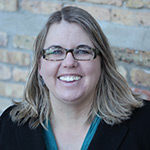
Sara Van Der Werf
Teacher, Minneapolis South High School
MCTM President
I was lucky enough a few years back to work with the best science teacher around. I’ve seen her student data and let’s just say her data is an outlier compared to any other science teacher. She is not just a little better than most teachers; her data is a lot better. Students that have had her as a teacher name her as their favorite teacher ever. She’s been nominated for many awards over the years, but she always declines to go through the application process that comes with most awards. This science teacher shuns any personal attention so most of you will never know about her. She quietly goes about creating in students a passion for science.
I asked my science teacher friend what she does different in her classroom and she said ‘the only way anyone can learn science is to DO science so EVERY DAY in my classroom we will DO science. EVERY DAY you will see my students back in the lab engaging in doing and learning science’. True to her word, every time I’ve walked into her room I’ve seen her students in the lab DOING science. (while nearby in another science classroom students are reading a chapter out of their science book and answering the questions at the end of the chapter in their notebooks looking bored) When I talk to her students, which I do often, they always are excitedly telling me (using the most amazing science vocabulary) what they’ve learned and many tell me that they want to be scientists someday. There is an aura of enthusiasm and passion about science that is infectious. I’ve wanted to learn what they are learning.
This article is part 4 of an 8 article series highlighting 8 words in the MCTM Mission Statement highlighting the word ‘LEARNING‘. (Here are links to part 1: ‘PROFESSIONALS’, part 2: ‘PROMOTING’, part 3: ‘TEACHING’) I, as President, am MCTM. You as a member of our organization are MCTM. Our mission statement gives us direction around our profession. In my series of articles I hope to give insight into 8 of the words it contains and how they inform our practice. Please take a moment to reread our mission statement.

My science teacher friend’s core value for her classroom was that students DO science everyday so that they can LEARN science. Her core value remindes me of a Paul Halmos quote you see around the web from time to time from Paul Halmos “The only way to learn mathematics is to do mathematics.” Halmos (1916 – 2006) was an American Mathematician who was also a writer and regarded as a great mathematical expositor. Halmos also is known for saying “applied mathematics is bad mathematics.” He adamantly believed that math students should do research at their level. He believed teachers could give definitions, ask questions, give direction but then we should say to our students ‘go figure it out, go to the blackboard and start thinking’. He also would say “Looking it up in a book is giving up.” He believed that the way to learn math is to do mathematics.
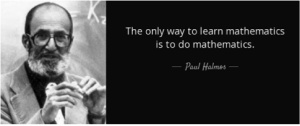
So what does Halmos’ vision of learning mathematics look like in our modern mathematics classroom? What does it mean ‘to do math’? How can we create classrooms where students are not passive receptacles of what we have to tell them?
As in past articles, let’s check out what NCTM has to say and then I’ll end with ideas from my own classroom on what doing math and learning math may look like. NCTM’s Principles to Actions (2014) says “Student learning of mathematics “depends fundamentally on what happens inside the classroom as teachers and learners interact over the curriculum” (Ball and Forzani 2011, p. 17). NCTM goes on to say “The learning of mathematics has been defined to include the development of five interrelated strands that, together, constitute mathematical proficiency (National Research Council 2001).”
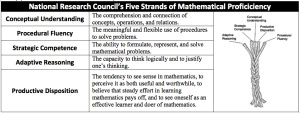
NCTM also highlights the Common Core’s 8 Mathematical Practices. Even though Minnesota is not a common core math state, I am quite jealous of these 8 practices. They challenge me. They define what ‘doing math’ looks like in our classrooms. Read the 8 mathematical practices and ask yourself how often you saw these practices in your classroom this week. I believe if we are honest, myself included, we all struggle to create classrooms where students are the owners of these practices. We all struggle to create classrooms where students DO mathematics in order to LEARN mathematics.
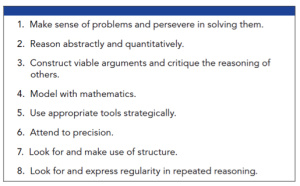
So what might the Learning of Math look like in our classrooms? Here are a couple of areas I am challenging myself in my own practice and I share with you.
- Take a look at the mathematical experience of the lowest achieving students at your school. If your school is like a typical school, they are most likely to be in math classes most void of ‘Doing Math’ experiences and then we shake our heads wondering why they are not ‘learning’ math. If this is true with your site or district, I challenge the teachers and leaders at your site to brainstorm how to change this. Not sure how? Use this as an impetus to learn as professionals. Research, read, learn. The answers are out there. OR come to the MCTM Spring Conference in Duluth April 29-30th, there will be many sessions connected to ‘Doing Math’.
- Students who struggle with believing they are mathematicians will be VERY resistant to being asked to DO math. They will complain (and their parents will often complain) that they want to go back to you just telling them what to do and they will mimic the math you show them. This may feel good to them in the moment, but research says -and if we are honest – our guts tell this is not what they need to be successful in the long term. Fight what is easier to do as a teacher and be bold enough to create classrooms where students are engaged in thinking, creating & doing math if you want them to LEARN math.
- Each fall I brainstorm what fears and concerns my students and their families may have entering my math classroom. I then work proactively to name these and eliminate them before they become a problem. Here are just a few of many I tackle every fall in order to create a classroom where students can learn (and I feel free to create experiences where students can ‘DO’ math.
- What is mathematics? I find many students don’t even know the definition of math. If I am to turn them into mathematicians who can learn separate from me, then they need to know math is the study of patterns and that mathematicians notice, describe and generalize patterns. They then need practice in doing these 3 things so it becomes second nature.
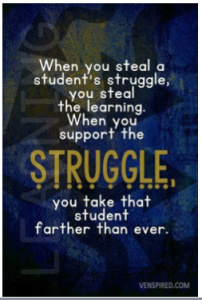 Students tend to give up trying when things get hard within 30 seconds or 3 minutes if I am lucky. How can I change this? I have LOVED using a quote from Malcom Gladwell book ‘Outliers’ to combat this with my students. To see this quote, check out where I blogged about his quote HERE. (note, scroll down to find his quote on 22 minutes)
Students tend to give up trying when things get hard within 30 seconds or 3 minutes if I am lucky. How can I change this? I have LOVED using a quote from Malcom Gladwell book ‘Outliers’ to combat this with my students. To see this quote, check out where I blogged about his quote HERE. (note, scroll down to find his quote on 22 minutes)- Students are afraid to make mistakes. How can I celebrate mistakes in my classroom as learning opportunities?
- Students do not believe they are good at math therefore I work to make sure ALL students experience success in math week 1 (and week 2 and week 3…) I do this through my choice of tasks with multiple entry points for all levels of learners.
- Ultimately this is all about creating a spirit of ‘productive struggle’ which is connected to the first Common Core Math Practice. Google ‘productive struggle in math’. There are lots of resources out there for this topic.
- Students are afraid to talk in class for fear of being wrong – to combat this read what Judy Willis says in her book ‘Learning to Love Math’ about asking low risk questions (Chapter 4 – Reducing Anxiety). Remembering to ask questions like this has resulted in more students talking in my classroom.
- Teaching must be measured by its results – learning. How do we know students know they have leaned? What kinds of things are you doing to measure your students learning? What I know for sure, by the time I get standardized test data (MCA or MAP), it is too late to do much to impact student learning and the data is usually too general anyway. I challenge you to use ongoing daily/weekly formative assessment prompts to measure student learning and make tweaks to your instruction. Exit Tickets are great – but only if you look at the data and do something about it – otherwise don’t even give them out.
- Max Ray, of NCTM’s Math Forum has put together some great videos of Doing and Teaching Math. If you are not sure what this looks like in the classroom, take 20 minutes to be inspired and watch a few videos. Share these videos with your colleagues.
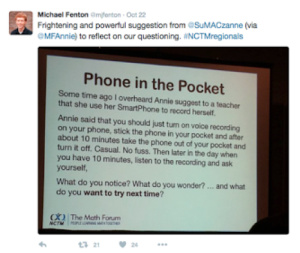 What types of questions are you asking in class? Do they encourage students to Do Math? To think? Are you saying ‘right’ too soon? Watch Annie Fetter’s new Ignite talk from December 2015 and take her ‘phone in the pocket’ challenge. Take a look at the questions you are asking.
What types of questions are you asking in class? Do they encourage students to Do Math? To think? Are you saying ‘right’ too soon? Watch Annie Fetter’s new Ignite talk from December 2015 and take her ‘phone in the pocket’ challenge. Take a look at the questions you are asking.- We have a POWERFUL tool right now for having students do the math and learn. That tool is Desmos. Are you using it? If not, stop what you are doing right now and go learn about it and use it this week in your classroom.
- Many of you know my favorite question to ask in the classroom is “What do you notice?” To ask this question in my classroom I have to make intentional choices to put something in front of my students to notice something that will lead to them learning about the intended learning outcome for the day. If I can’t ask the question “What do you notice?” to my students at least once a class period, then I am probably doing the math for my students. They are not doing the math for themselves and probably not learning too much. I challenge you to build the question “What do you notice?” into every math lesson you teach.
During the 2015-16 school year I am trying to LEARN how to ride a backwards bicycle. (Click here to see what I am doing) Everyday I practice. I am not learning how to do this by watching videos or having someone tell me how to do this. The only way I will figure this out is to DO it. After 3 months, I still look about as bad as I did when I started and I practice every school day. I will not give up though. I am committed to figuring this out. I can only LEARN if I do.
Everyday I walked into my friend’s Science classroom (I talked about her at the start of this article) I observed students Doing science. E.V.E.R.Y. D.A.Y. EVERY. Can you say this about your classroom? If we believe that we learn math by doing math then anyone could walk into our rooms on any day and see at least a portion of the lesson dedicated to all students doing math. If we take this on as a personal challenge as a teacher I am confident that the number of students LEARNING math will increase in all of our classrooms.
I love connecting with math teachers, especially those of you from Minnesota. You can find me on Twitter @saravdwerf or Email me at sarav@mpls.k12.mn.us or check out my Math Teaching blog at saravanderwerf.com
